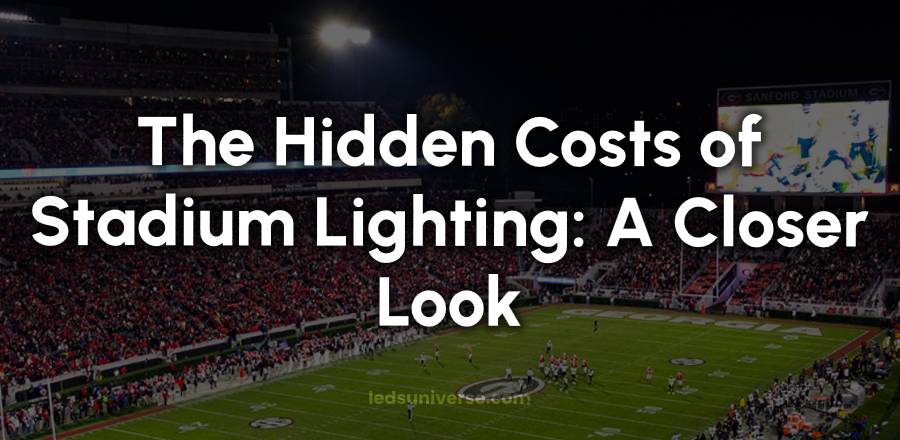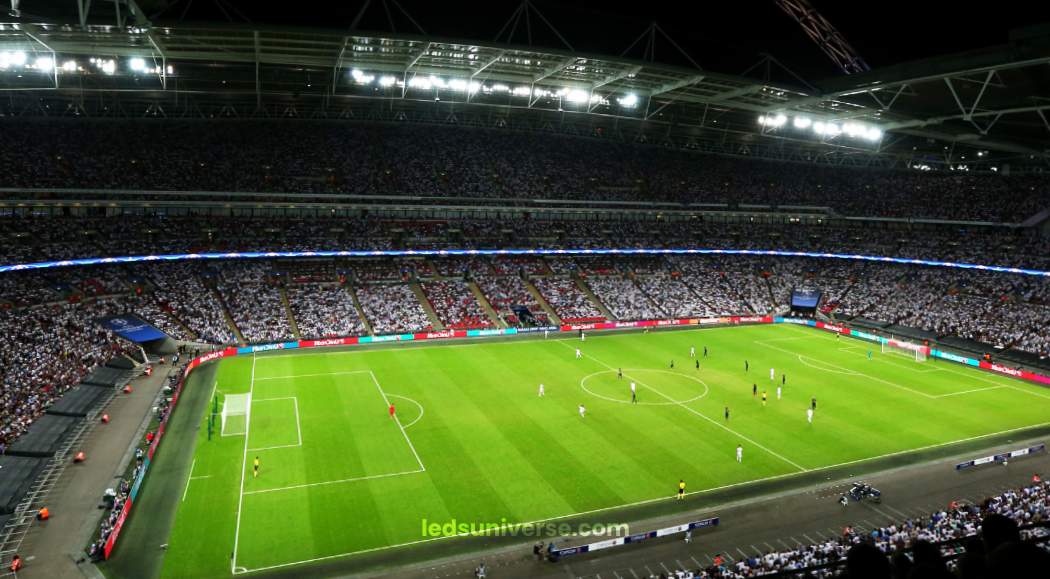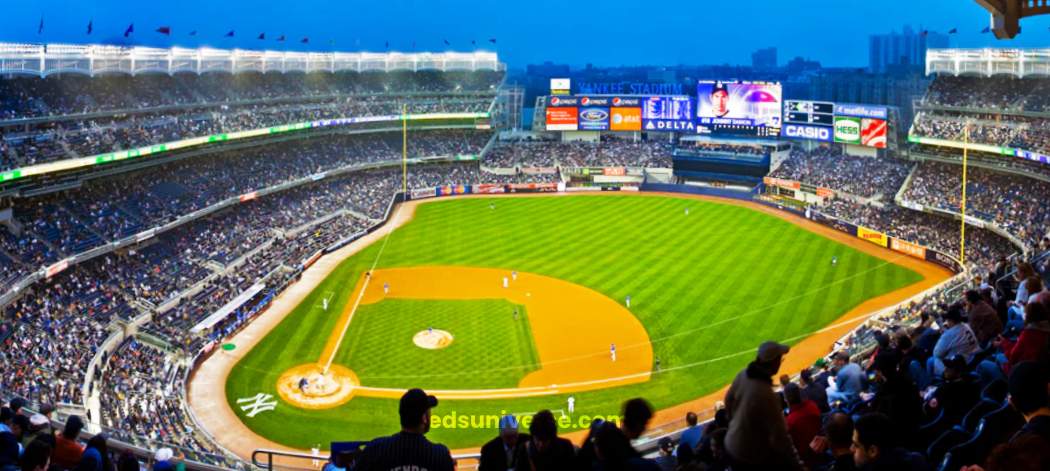
Stadium lights illuminate unforgettable moments, from game-winning goals to thrilling touchdowns. As venues evolve, High Mast LED floodlights are quickly outpacing traditional Metal Halide systems. Offering enhanced energy efficiency, longer lifespans, and lower maintenance costs, LEDs provide a brighter and more sustainable solution for lighting fields. This shift promises not just improved visibility but also substantial savings, solidifying LEDs as the future of stadium lighting.
When it comes to illuminating stadiums, sports fields, and large outdoor venues, upgrading from traditional lighting systems to modern solutions is a common challenge. Many customers inquire about the costs and efficiency of upgrading their stadium lighting, particularly when it involves replacing older 1000W to 2000W Metal Halide lights with LED floodlights.
Reach out for free lighting consultation
Table of Contents
ToggleOne of the most common questions customers ask is about the level of lighting needed for their stadiums. For most football fields and similar outdoor spaces, a lighting requirement of around 200 lux is typical. However, some venues may require much higher levels, particularly those that host professional matches or events that are broadcast on television. Higher-end venues can need up to 1200 lux, particularly when weekly HD or 4K broadcasts are required. The exact lighting needs will vary depending on the size of the venue and the level of competition.
For a standard football field, aiming for an average of 200 lux means that around 22,000 watts of LED lighting will be required to illuminate the entire space. This typically involves using between 20 to 24 fixtures of 1000W LED floodlights, depending on the specific configuration. For higher-end fields requiring 1200 lux, the wattage and number of fixtures would increase accordingly.
| Aspect | Metal Halide (MH) | LED Floodlights |
|---|---|---|
| Initial Cost (per fixture) | $800 – $1,200 | $1,000 – $1,500 |
| Total Fixtures Needed (for 200 lux) | 20 – 24 fixtures (1000W) | 20 – 24 fixtures (1000W) |
| Total Installation Cost | $18,000 – $25,000 | $18,000 – $25,000 |
| Energy Consumption (per fixture) | 2500W | 1000W |
| Total Energy Consumption (32KW requirement) | 100KW | 36KW |
| Energy Cost (per hour) | $13.00 | $4.68 |
| Weekly Energy Cost (5 hours/day) | $455.00 | $164.00 |
| Annual Energy Cost | $23,660 | $8,528 |
| Estimated Annual Savings | – | $15,142 |
| Lifespan (hours) | 2,000 – 3,000 | 120,000 |
| Maintenance Frequency | High (frequent replacements) | Low (infrequent replacements) |
While 200 lux may suffice for most non-professional venues, customers sometimes request higher lux levels for special purposes or more intensive lighting needs. Budget considerations come into play, as increasing lux levels or using advanced models of LED lights can significantly affect the overall cost of the project. The budget for a typical football ground requiring 200 lux generally falls between $18,000 to $25,000, depending on the LED model chosen. Although LED systems tend to have a higher initial cost compared to Metal Halides, their long-term benefits far outweigh the upfront expenses.

When comparing LED floodlights to older Metal Halide lighting systems, the advantages of LED lighting become clear in several key areas. While the initial costs of installing LED systems may be higher, the savings in terms of energy efficiency, maintenance, and lifespan make LED lighting a superior option in the long run.
One of the primary reasons for switching to LED lights is the significant reduction in energy consumption. LED floodlights offer approximately 65% energy savings compared to Metal Halide systems. For instance, a 1000W LED light can replace a 2500W Metal Halide light, reducing overall power consumption. LED lights also draw only about 10% of the power from the grid, while Metal Halides consume 25%, making them significantly less efficient.
To illustrate this, consider a stadium that requires 32KW of LED lighting to achieve the desired lux level. When using LED lights, the actual power consumption would be around 36KW (32KW * 1.1), accounting for the power draw of the system. In contrast, a Metal Halide system would require a whopping 100KW (32KW * 2.5 * 1.25) to achieve the same lighting effect.
This energy efficiency translates directly into cost savings. If the cost of electricity is $0.13 per kilowatt-hour, operating the LED lights for one hour would cost $4.68, compared to $13 for Metal Halide lights. Over the course of five hours per day, the weekly electricity costs for LED lights would be around $164, while Metal Halides would cost $455. Over a year, this would amount to a savings of over $15,000 by switching to LED lighting.
Another major benefit of LED floodlights is their longevity. Most LED lights have a lifespan of up to 120,000 hours, far surpassing the lifespan of Metal Halide lights, which typically last only two to three years. This extended lifespan not only reduces the frequency of replacements but also minimizes ongoing maintenance costs.
The shorter lifespan of Metal Halide lights means that bulbs need to be replaced much more frequently, leading to higher maintenance costs. Additionally, the performance of Metal Halide bulbs tends to degrade over time, causing dissatisfaction among users. LED lights, on the other hand, maintain their brightness levels throughout their lifespan, providing more consistent performance and reducing the need for frequent maintenance.
To better understand the practical implications of replacing Metal Halides with LED lights, let’s consider an example of a football field project. Imagine a standard football field measuring 105 meters by 70 meters, where the customer requests a lighting solution that provides 300 lux. Based on the size of the field and the required lux level, our team would design a proposal that balances performance, budget, and lighting needs.
In designing the solution, various factors would be taken into account, including the customer’s budget and the specific lighting requirements. We offer a wide range of LED models with different specifications and prices, allowing customers to choose the solution that best meets their needs. The number of poles, their height, and the beam angles of the lights all play a role in determining the final setup. For a 300 lux requirement, the total lighting power would be adjusted accordingly, potentially requiring a higher wattage or more fixtures than the 200 lux example mentioned earlier.
One aspect that can significantly impact the effectiveness of the lighting is the design and placement of the poles. For example, fewer poles would need to be taller to maintain uniform lighting across the field, while more poles could be shorter. In cases where fewer poles are used, we employ small beam angles to ensure that the light beams travel further and provide sufficient coverage. This ensures that the entire field is illuminated evenly, without dark spots or shadows.

When considering the switch from Metal Halides to LED lights, one key factor is the difference in energy consumption between the two technologies. As previously mentioned, the replacement rate of Metal Halides to LED lights is generally 1 to 2.5. This means that a 1000W LED light can replace a 2500W Metal Halide light, leading to significant energy savings.
LED lights draw approximately 10% more power than their stated wattage due to the efficiency of the system, while Metal Halides require about 25% more. This means that while a 1000W LED light actually consumes around 1100W, a 2500W Metal Halide light will consume approximately 3100W from the grid.
For a stadium requiring 32KW of lighting, the total power consumption using LED lights would be about 36KW. In contrast, a similar setup using Metal Halides would consume over 100KW, more than three times the energy required for LED lights.
Switching to LED floodlights involves not only an upfront investment in new fixtures but also long-term savings in energy and maintenance costs. The financial benefits become even more apparent when considering the reduced operating costs over time.
As mentioned earlier, the cost of running LED lights is significantly lower than that of Metal Halide systems. With a typical electricity rate of $0.13 per kilowatt-hour, the cost of operating LED lights for one hour is about one-third of the cost of operating Metal Halides. This difference accumulates quickly over time, resulting in thousands of dollars in savings annually.
For a stadium that operates its lights for five hours per day, the annual savings from switching to LED lights can exceed $15,000, as LED lights use only about 35% of the energy required by Metal Halides. These savings make the switch to LED lights a financially sound decision, even when taking into account the higher initial costs of the LED system.
The number and height of poles in a stadium lighting system play a crucial role in determining the effectiveness of the lighting. Taller poles can be used to cover larger areas with fewer fixtures, but they may require more powerful lights and smaller beam angles. Conversely, more poles can be used at lower heights to achieve a similar effect with wider beam angles.
There are several different pole configurations that can be used in stadium lighting setups. For example, a system with four poles might use poles that are 35 meters high, while a system with six poles might use poles that are 25 meters high. Alternatively, eight poles could be used at a height of 10 to 15 meters. The specific pole setup will depend on the size and layout of the venue, as well as the desired lighting effect.
The placement of the poles also impacts how evenly the light is distributed across the field. Poles placed at the corners of the field will create a different lighting pattern than poles placed along the sides. Different venues may require different lighting solutions to ensure that the entire area is evenly illuminated. This level of customization can affect the overall cost of the project, but it ensures that the lighting system meets the specific needs of the venue.
In the evolving landscape of stadium lighting, transitioning from Metal Halides to LED floodlights presents a compelling opportunity for venues to enhance illumination while achieving significant cost savings. The benefits of LED technology—ranging from energy efficiency and reduced maintenance to longer lifespans—make it an advantageous investment for both operational effectiveness and financial sustainability. By adopting LED systems, stadiums can not only meet varying lighting requirements but also contribute to a more environmentally friendly future, ultimately making LED lighting the preferred choice for modern sports facilities.